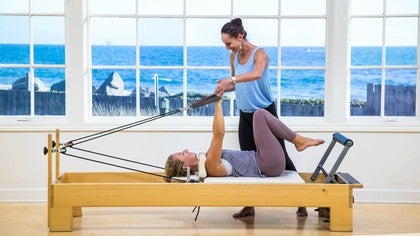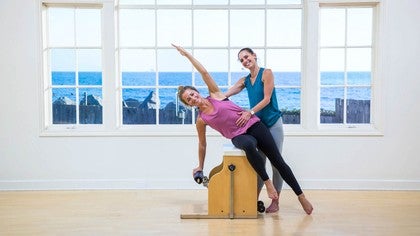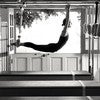Description
About This Video
Transcript
Read Full Transcript
Hi, thanks for joining us today. This is Tucker. Tucker and I are going to go through a series of sessions and we're going to train her from the bottom to somewhere. So on. Tucker and I decided to do this series quite a few months ago, and then only just last week we found out that Tucker has a broken rib. So we're going to approach it a little differently than expected. We're going to work around it.
And this is just like a real life teaching situation where you have something planned and then things don't go as planned and then you work it out. So we're going to start very, very basic today. So what I want you to do is I just want you to sit with your feet side by side. Actually, I changed my mind. Lie down onto your back. The first thing that we're going to talk about is breathing because I feel that breathing is so important in potties, but oftentimes we gloss over the details of the breathing and then we just talk about the inhaling and exhaling. So Tucker, what I want you to do is I want you to rest one of your hands on your sternum and I want you to arrest one of your hands on your belt. Okay?
I know we get to think about doing anything right now except just taking a deep breath and we're seeing what happens. Natural breath. And then let that go and do that again. And I just want you to notice what happens in your body naturally when you take that deep breath. So you'll see the chest wall rise, you see the belly wall rise. And the reason for that is because the diaphragm is having to make space, right? Make space. So the diaphragm inhale, let your belly rise. The diaphragm drops down into the visceral cavity and aired step into the lungs and then it relaxes. The belly wall relaxes. We'll do one more like that.
This is just diaphragmatic breath, totally different than what we're going to ask her to do in a minute, right? So now what I want you to do is instead of having your hands on your sternum in your pelvis, I'm going to have you just rest your hands on the opp and the two opposite sides of your ribs. So before we do anything, what I want you to feel is that we're going to talk about transverse abdominals. So what I want you to do is I want you to, I'm going to rest my hand on your pelvis and I want you to just pull lightly down away from my hands in the, in the lat lower abdominal area. And I don't need to tuck your pelvis. I just want you to feel like you're trying to pull my hand down into your body. Good. So nothing happened under your hands, right?
No contraction happened there. And then let that go. So it's just a, it's just a drawing down, almost like you're trying to pull your two sitting bones together. And so then we feel the down here, it's syncs. She's the difficult concept. Kids, I just pull my hand down. Sometimes it just helps to have some weight down. Yeah. Let my hand sink down into your body. Yeah. Okay. So the, it's not a, it's not something that you can find really by grabbing for really forcing, it's just that sense of like a lightening and [inaudible], huh?
[inaudible] even more. [inaudible] now I want you to keep that organized, meaning you're going to inhale, but you're not going to allow your belly to rise like you did before. And this time, instead of allowing the belly to rise, I want you to breathe into your rib cage. So I want you to feel that you're trying to pull your hands apart with your breath. So the breath travels through the sides of the ribs. So I've worked with Tucker a little bit and then we're going to exhale.
Allow that low belly to soften. So you're still doing a little bit more external oblique than you're doing most anything else. So what Tucker has made a habit of, and we're going to see if we can help her, is she's does a lot of extra low bleak, but she want, we want her to go go little more deeper into her deep, deep muscles. So pull my fingers down and let's do that. Inhale again. So big expansion of the ribs. So the ribs will go three dimensionally. They'll go to the back of the body and they'll go to the sides.
Now more than just the muscles around your ribs, I want you to find these muscles here, thinking, thinking, thinking, thinking. Okay. So what I want you to do is just help yourself up. We're going to play with that from a different angle. I'm going to have you turn around, just let your feet dangle. So we're going to speak a little bit about, I'm right here where we're going to speak a little bit about trying to, um, find some pelvic floor engagement. So Tucker, what I want you to do is you can close your eyes and just bring yourself into your body. I want you to imagine that you have your two, you feel that your weight is on your sitting bones, right? Yeah.
So you can even go a little forward on them. So what I want you to do is I want you to imagine the space between your pubic bone in your sitting bones. And your two side hip joints. I just want you to feel that you're almost trying to squeeze your sitting bones together and I want you to do it from right down here. It will feel like you're gently lifting. That's pretty good. Can you do it a little more? Yeah. Good. And then let that go.
So what I'm asking her to do is find a little bit of transverse and a little bit of pelvic floor. So imagine that you have, imagine a ball of energy underneath your pelvis. Now I want you to pull that ball of energy into your pelvic bowl and huh? Yep, yep. Hold it there. Keep breathing. Now pull it up a little higher and in this is difficult. It doesn't, it doesn't look like anything, but it's difficult. Now Paul, ball of energy is going up one more inch and we want to pull back against.
So what I'm asking for is a little bit of pelvic floor transverse action. Now do that one more time. Pull it up one more inch and pull back against him. Yeah, Tucker, it's easy for her to do sitting up than it is for her to do lying down. Now Tucker, I want you to let that go and say in step, let it go down a little. Let it go down a little bit. Keep pulling back against it.
Let it go down a little. So we're trying to train a different concept of abdominal engaging and it's going to take a few steps and it's gonna take some practice. And that's what Polaris is all about. Learning skills and practice. So what you're going to do, Chuck with this is you're going to take it and I want you to wrap it around the back of your ribs like this. So it's touching the back of your ribs and then you can cross it around the front of you like that. Okay, here you go. Make sure it stays nice and wide.
I'll help
I want you to find that sense of finding the sitting bones, squeezing them together, lifting them slightly, pulled back against my finger. Now I want you to hold that contraction as you try to spread the bandwidth. Your ribs breathe in, the band widens, you can let it widen, you can like let the arms help you and then go even more back down here and let the ribs close as you exhale. Yeah. Okay, let's do that again. So pull in, pull my fingers back now that not keep that back and soften. Don't squeeze the ribs. Just allow them to move and actually pull them up against me. Yeah.
Now let the rib let try and make that band expand. So let, let, let yourself give it space to expand
That's what's happening in her body right now. They're clicking against each other and it's pretty uncomfortable feeling I imagine. Okay. So we're done with this, unless you want to use it still. Okay. Okay. I'm going to put it away so tat go back down onto your back. So going into the very most simple of movements. So I want you, once again, you're going to put your hand here but leave space for my hand cause I'm going to poke U2. And then you're going to put this hand here. Now what I don't want is I don't want rib pushing, right?
So a lot of times we hear as Pilates teachers or students, drop your ribs, connect your ribs, squeeze your ribs down. That's not what I want from her at all. I actually want her to just feel that she's soft in that area and that she can just feel her. All of her ribs are on the mat, but I don't need her to do any more squeezing than that for right now. So what I do want you to do is I want you to feel that as you inhale, your ribs do drop. Yep. So you inhale, you find that the, yeah. So let's take a deep breath. You breathe into my hands, letting the ribs expand and then feel the tissue underneath your hands. You find it like I was pushing on you to write down in here. Pulled that back.
Pull that back. Pull that. That's it. Okay, let's do that one more time. Inhale. Find my hand. How out out. Out, out. We want to spread those intercostals. We want to get them to stretch. They're tight and then it's not a big contraction. It's more in the low, in the lower part of the body that I want you to think of them.
Then ride around and up here. Let's do that one more time. How does that feel? Does it feel hard? Difficult to find? It's okay. Good. So this pulls down [inaudible]
We got all allow the ribs to stretch. We stretch that intercostals the muscles in between the ribs and then we don't create excess tension, but we just let the ribs soften again. We're going to add movement to that now Tucker, you're ready. Okay, so I'm going to put my pokey little fingers back down here and I want you to take another inhale. I know. Don't want you to push out on mat wise. I want you to pull away from me. Yeah, nice. Now as you exhale, I want you to keep this even more connected if you can, or at least don't push out on me and lift this leg. Oh, inhale again. Start your exhale. Pull down first. That's what I want. Keep pulling down, pulling down, pulling down, pulling down, pulling down, pulling down.
It's like the most difficult leg lift you've ever done. High. They made nail down. Now do that again. Pulled down first. So yeah. Can you find it first and then you left? That's it. I lift from there. Pull down. Pull down.
Yeah. We're going to Xcel to pick up your leg. Tucker was curious about her breath and I want her to start exhaling and to move her leg as she's actually, I just sounded like a cow. I said move. We're really going to do two more on that side, so this is good. This might seem super tedious at first. I'm sorry for you following along, but if you practice this and you try and you put your hand on your own body and you feel that you're pushing out on yourself, try different.
She's doing much better. Okay. So we're going to put that one down and this is what you're going to go home and practice, right? You're going to get better at this and it's gonna, it's gonna. It will start to feel easier. We just have to train these muscles and um, train out of a habit and into a new one. Okay. So just inhale and exhale and we'll skit set up again. Okay. So now, one more. Inhale.
Excellent. Again, I'm, I'm gonna have you inhale less chest, more outer ribs. Better now start your exhale. Star lifting. Yeah.
So I'm just feeling, and she can feel it too. She can feel if she's pushing out or pulling and because I'm teaching or what it feels like without actually telling her what it feels like cause I'm showing her with my fingers when she's doing the thing I don't want her to do. And then she's can feel that with her own hands. Let's do it again. She can feel that now she has a sensation underneath her own hands of the, of the, um, recruitment pattern that I want so that this is not going to be perfected in today, but she has the skill now. Go. That's it Tucker. That's it.
She's got the skill now is what I'm saying. And she has the feedback from my hands and her hands, so she knows what to do. Fine on her own and we'll revisit. But before I see her again, she's going to practice getting really good at this one time. You're doing great. Now the more difficult thing is coming next. Are you ready? Last one.
Okay, so now we're going to drop one and lift one without doing any of those changes. So you're going to inhale and then as you exhale, I want sinking. I want softening and I want leg change. Nice. We're just gonna go really slow in here thinking, softening Lake. Ah, you feel it? She pushed out. She pushed staff. That's it.
It's so difficult. It's so difficult. It's so difficult to do this really clean again. That's it. I get it. Pull on. Pull input. Input. Oh, deeper Tucker. Deeper, deeper, deeper. That's better. One more time. She's getting better about doing that. Inhale.
Yeah. Watch how much does the chest or the, how much the neck breeze and and really focus on the ribs. I again go, it's unbelievably difficult. One more time. I think that's going to be the end for you to do a really good one. Oh, pulling, pulling, pulling, pulling. Oh, there it is. There it is. Okay. Ed rest. It's so hard. It's so hard. It's much easier to just make the shapes right, but we'll get, we'll get there.
So another thing that I want you to notice is a lot of times people who have a little bit of tightness in the shoulders, and I'm not suggesting you're the only one who has tightness in the shoulders. I also have tightness in the shoulders, but what we do is when we have a little bit of tightness in the shoulders, in the shoulders, want to lift up off the mat. What we as pilots teachers here when we hear shoulders back and down is we pinch our shoulders down to the mat and we squeeze our scapula together. Now what happens when the scapula's squeezing together as it doesn't leave any space for the back of the chest wall to lay down on the floor of the back of the ribs to lay down on the floor. So that's challenging if I say get your shoulders back and down and also put your ribs down. I'm asking her body to do two completely different things.
So what we're going to do with you instead, Tucker, so go into that kind of pressing your shoulders back and dad, now try to push your ribs down. Now you can, right? So you feel that that's difficult. Different things want to happen. So what I want you to do instead is I want you to just let go of that idea that the shoulders have to be all the way flat for today and just feel instead that the scapular are real wide. You could even turn your palms like that. Yeah. And so now what you'll feel is that you have space just to relax the chest down through the shoulder blades and it doesn't feel so difficult to let the ribs sit there, right? You don't have to fight with the ribs.
So we're going to let go of that fight too. So anytime you feel like, Oh geez, I'm really trying to, how do I do that? Check in where your shoulder blades are and that may help you. So we're going to have just a very simple bridge. So what happens to what with Tucker, with her rib situation is when she goes the, uh, when she moves through that space, the one that's floating, this one down here kind of tucks underneath the one on top of it and it makes this little clicky thing. So what Tucker and I are going to try to do is we're going to try to get longer.
So we're going to try and go around that place. Okay? So all I want you to do, I want, you did not do anything with your ribs. I want you to allow breath to happen. And now I want you to let your low back start to soften on the mat. So it happens from the deep place, the deep place, the deep place. Good. And then the pelvis starts to change. Yeah.
And I still don't want you to drop your ribs. I just want you to start to lift your pelvis, keep your rib soft, and then that's the section, right, right in there. So right there you can start, continue lifting, but reach out, reach out anytime. If you feel like you're on the verge of it, you just tell me, okay, I know what it feels like to hurt. I've, I've, um, I and I can maybe now start to see when it happens. So now inhale there, Tucker, not in the chest, but in through their ribs like we practice. That's it. Now think just of softening the breastbone, you don't have to push it.
You don't have to go really, really vigorously through the rib area, but instead start letting the low spine round and feel that you're stretching out, stretching out, and really get those deep abdominal muscles to do that work for you. How'd that feel? Okay, awesome. I'm going to do it a few more times, so I want all the time as your inhale and that big wide expansive rubs. That's awesome. You feel how the chest is staying like a little more relaxed now. Now exhale, allow the pelvis to change. Stand on your feet and begin rolling up your lead.
Stand on your left leg a little more than you are. Good. So you stretch out. We're not overextending through the ribs. Recreating a straight line. You can lift up a little higher than you are Tucker. You still okay, cool. I'm just going to help her find where straight is that. We all have a little pelvic rotation. I think that's, I don't think I've met a person who doesn't and now we're going to go down and I remember you don't want to bear down into that place, but instead just let the ribs soften.
Think about what's happening in the lower part of the abdominals rather than the sides of the abdominals. Right? The deeper abdominals as you lengthen out, pulling out of that space and damn good. We're going to do it again. So for now, Tucker and I aren't going to practice a lot of held flection. Are we going to do things like we just did? Which if we ask her to do them from a really honest place in her body, a really muscular aware place in her body is gonna be more difficult than just making the shapes for the choreography for right now.
So I'm speaking of things like chess lift, Chris cross hundreds. We're going to get those deep muscles firing once they do. Nice that it was that anywhere near it. No. Awesome. I felt, I thought I felt a little click, but she's already Opal and [inaudible] and all the way down. Okay, Tucker. One more time then we'll do something else. So yeah, we're not going to do any loaded flection right now. And last one we're going to do more elongation of the spine, some deep abdominal work. Stand on your left leg, lift your left pelvis. That's it girl. Good.
How's it feel on your shoulders? Everything's fine. She's happy. The hard part is the brain part right now. Go when you're ready. The hard part is the brain part and really tapping in deeply. So we teach you, we teach the brain to teach the body to move in a different pattern.
We're going to leave the mat talkers going to practice those skills. When we meet again, she's going to show me how much she's improved and then we're going to go over to the reformers. So we'll be right back. Okay. So what we're gonna do now is we're going to try to apply some of those concepts into your basic foot and leg work. We're not going to do fast reps, we may not do a ton of reps, we may not do all the foot positions today, but we're going to try to take that idea of breath and center body connection and apply it to some foot work. Okay? So why, why don't you, I would say three reds with three reds in a blue. You may decide I might make a different choice if I don't get the results that I'm looking for. Perfect. Okay. Go on your back. Okay.
So the first thing I want to make sure I do is I want to make sure that she's straight on the reformer and I'm, it's easier for me to do that then for her to do that. So scoot your pelvis a little towards the ocean. Ah, that's too much. So are those ocean everywhere? Oh my God. What are we going to do? Come to the left. Come to your right. Okay. Okay. So let's take the feet. We're going to start on the heels.
Now we're going to take this again. We're going to break it down. So remember what we talked about in the shoulders. It's not critical for me for you to have your shoulder blades pinned down flat. So what is critical for me is that you feel that your ribs are soft but you're not really having to force them down and like have that conversation between the ribs and the shoulder blades. I'm going to get down here so I can be very nosy about what's happening.
Okay? So why don't you to put your hand there and leave room for me cause I'm going to put my hand in there too cause I want to feel so that I know, I know that you're feeling what I'm feeling too. Okay, so I've got my hand here. Tucker's got her hand here. We're just going to cause then I want her to feel that that's that that skill that we learned is, is being processed here. So the next thing I want you to do, Tucker, is I want you to push into your heels without pushing on the reformer yet. So you feel how that, that can even more push into the bar and slide your heels and down on the bar energetically. So that, that's it. I want.
So I'm trying to get her to fire up her hamstrings and that helped. So you're just pushing on the bar. She's pulling down on the bar. Now inhale. And now as you exhale, I want you to first sink. Now start pushing. Yeah, go. Yeah, push out. Push out. Push out. Pause there.
We're going to find more of a neutral alignment in the pelvis. Now she's going to have a little bit of space in her lower back, but we want to get the ribs to just drop down. So that's great. I want you to keep your pelvis right, like it is pushed into the bar with your heels. As you bend your knees and come in. I'll stay out of your way it, we're going slow. Inhale again without talking and without pushing. Ask. Thank you. Now push. Now.
Keep that inward connection as you straighten all the way and bend.
So on another day I'll walk around and see what's happening in other places. But for right now we're really focused on where the work is coming from an initiation perspective. From an initiation perspective, how does the Springfield, that's good. It's good. Okay, go on your toes.
So inhale now I want breath and then movement. Okay. And Ben and inhale breath ribs. Soften. Not force and push. Stand on my hand and bed. Yeah. So by having her stay with me, I'm actually, I'm just queuing the heel position, which I'll describe in more detail in a second.
Pull in and now with the breath. So she's doing a two breath process is just fine for me. It slows things down a little bit, but I don't mind because she's really concentrating on finding the work in her center and maybe she, maybe that's what she needs. So she's inhaling down there and inhaling here and I don't mind and I'm just asking her to stay with me with her feet. Go ahead and push. Yeah. Good. And talk her now.
So here her feet are pointed and push on your right big toe. And here as she bends the ankle changes shape here at that joint. And we do one way. This is your area. Focus not here. Good. Yeah, she's doing great. It's very, um, I imagine she's already though. She's already from start to now.
She's already integrating. Yeah. And it's difficult, but she is a smart girl and a very, um, a very, what's the word? Tucker. Dedicated. She's a very dedicated student and she wants to, she wants to understand which is um, it's exciting. So let's do it. So here I want you to squeeze the backsides of your legs without changing your pelvis. Thank you. Push into the bar with your feet and keep that sensation. Good. I never want you to push out on your hand.
That's right. And now she knows what to feel for and I've, I've, I've stopped cause I can see
And by squeezing her pelvic bone, she learned how to create that sensation, I think. Yep, go again. So now I don't have to squeeze her pelvic bone. She can squeeze her pelvic bone. She just knows what it, what I want her to feel like, I think. And uh, this space narrows. Yeah. And you might even be to see the change because I can. Okay. Talker, that's enough. We're going to go back into a parallel. Yup. And you've just on the toes. I want you to push out for me.
Find all of the pieces. Now from there we get the knees aligned. I want you to feel that you're in that neutral alignment with your pelvis. You're not forcing this. It's just soft. Now take your heels underneath the bar.
Now I want you to imagine that your heels are connected right here, touching where our hamstrings meter glue. And now I want you to tighten here. That's it. And I'll lift from there.
This teaching Palladio's game. Gotta use all the things and got to use all the skills. One more now Tucker, just like in the leg changes. Lift your heels.
Yeah. Pelvic squeak. Well, pelvic, thank you. And down pelvic squeeze. Better. One more time to each side. San [inaudible] powers your movements. I was a little quiet. Okay, that's enough. Ben both knees. [inaudible] you can do one more if you want.
Let me just make sure there. Even if you would. Yeah, let me measure them. They're not
That's what we do not want. Okay, so I want you to actually reach forward a little bit until you feel that they're flat. You're going to push on the ropes a little bit. I want you to really reach you, your elbows there. Yeah. Good. So this is an arm moving thing, but we're going to try to relate it more to the center of the body. I'm going to lift one leg ready deeper or don't push out. Now she can't pull it. She can't feel it. So I'll feel it for Poland.
Yeah. Okay. Okay. Okay. Okay, Tucker. That was okay. It wasn't perfect. Yeah. So we're going to inhale. I'll try to stay out of your way, but I, you need pokey fingers. Here we go. As you exhale, you're going to pull away from my hand. I'm not actually stabbing her, but I am putting my hand in such a way. Pulled my hand down, down more and [inaudible] and now lift you go as fast as you want. I think slower is going to be better. Okay. Pull down. So what you could imagine talk is that pull in here more. Bring your knees a little closer. Bend your knees more.
So I'm going to take her hip flexors out of the equation a little bit. Okay. We'll get back to the tabletop later. Lift your arms. Now I don't want you to think of pushing with your arms. I want you to not move your arms out. I want you to find your deep breath, deep breath. And now as though you're breathing your arms down, I want you to use your ads. Now are your abs connect to your arms? No, they're not. But they're connected to your brain. Yep. So now go deepen a pull down.
That's what I want, Tucker. Now keep pulling down. I now left. I got to move more deeper. Yeah. Good. This is good. Deepen. I'll get out of way. Yeah, she didn't let it go when I let her go. That's good Tucker. You've got it. It's a whole different sensation. Hey, so she knows this exercise. We're just changing it for her brain quite a lot. Yeah.
So we don't want a beer down in that rib area member. Right? That's not going to do you any favors. You want to find the muscles that are working a little bit lower than that. Pull my hand down. That's it. Tuck. Go ahead. Now lift one more. You don't need your ribs. Yeah, like you're pulling with your tailbone going down and your belly button is connected to your hands and only by pulling your belly button back.
Yeah, that was a good cue for you. That was so good. Let's do that one more time. Good. Go up. So it's not about the hands, it's the belly button moves the hands, belly button moves the hands as so keep pulling back. It can't push out or else the hands don't have anywhere to get pulled from. That's it. Now stop. Turn the palms of your hands face in. Why so different? It's so different.
So this is one of my favorite ways to think about breathing here. You okay? So imagine that your arms and your ribs are doing the same thing. Belly button stays pulled back. You inhale and your ribs expand in the direction that your arms expand, like a bellows, you know, a fireplace, bellows. And then as you pull back down, you pull the belly button down, the belly button pulls the arms. That's your cue from now on. Yep. Down, down, down in the ribs are allowed to come back together.
Now that we're not squeezing ribs, right, we're just moving in and out in her belly in. Now find me here and start exhaling. And then imagine that you have to exhale all of the air out of your body. Pull Dow. Oh, that's a little Blinky. Pulling here more here. That's it. That's it. And inhale.
So your exhale starts in your pelvis. That's it. That's it. I'm just feeling, I'm feeling for contraction. I'm feeling for push out and you can feel it. It's hard to do on your own if you're practicing on a reformer, but it's easy to feel if you're teaching someone in Poland, but not everyone has the patience as Tucker out or the desire to work this mentally and this deep. So we have to keep that in mind. But Tucker does and that's a good, that's good news for her. Good news for me.
Good news for everyone. Pull in, pull in more. Thank you more. Thank you. Yeah, it's tough. One more.
Okay, so tuck. The last thing that we're going to do is we're just going to do a little bit of hip work. So what I want you to do with your feet is I want you to push out on the bar. If you're going to straighten your knees, you're just going to step into this drop so you know how to do that. Okay?
So you're going to bring your heels together and your toes apart. Yeah. You get to go back on your own pelvis. Yeah, you're there. That's exactly right. So what I want you to do here, and we're going to wrap, this is going to be the wrap up for our session today because what our desire is is to bring the information from the breathing from the beginning of the class and just take it into some very simple movement. Put your hands on your pelvis. I actually do want them there and do that. Do that thing like where you had your hands. Actually it's okay.
So there's two choices. One could be like, you know what it felt like when I squeezed your pelvis. You could do create that sensation or, yeah, I think, I think I like that, but I don't want you to lift your tailbone. Now. I want you to keep your tailbone all the way down. Okay, so now allow the ribs just to lace restful. Bend your knees. No, I don't want you to push with your feet. I want you to feel that your torso, your abdominals is starting to action first. Now go ahead.
You're going to start breathing now. As you breathe in, you sink. Then your legs travel towards me. Yeah. I don't want you to feel that there's any outward pushing. Inhale to Tibet. No. Start softening their ribs. Squeezing the two sides of the pelvis towards one another.
Keeping the tissue underneath your finger tales. Finger tales. Do you have finger tails? What are their fingernails? Fingers. Fingers is what I meant to say. Finger tails. I have no idea where that came from. An bend. Yeah.
Maybe I meant to say you could use your finger to remind your tail to stay down on the carriage and stop there. So now we're going to go around. Oh, sorry. We're going into leg circles. Tacos. That was a bit, that was a little bit abrupt. Okay, so the next exercise is the leg circle. You're going to go out. I want you to feel at that. I want you to feel that space underneath your hand stays very still. I don't care how big your circles are now.
I don't want you to push with your feet. I want you to push from the back of your legs and from your [inaudible] belly button. Cut. That's enough. Go out. Up. Tail stays down. Do you feel the right hip lifting a little. Yeah. Yeah. Keep that down. Okay. That's something that was, it was a subtle cue, but I could see it and I wondered if she could feel it and she could and I, the way I know that is cause I asked her, keep the right hip down. That's right. Talk one more brass connection.
Mind body. Stop there. Go the other way. Back of the legs. Not the fee. You're pulling up through your trunk like that pelvic floor thing that we started with. Think about that. Lift the legs.
Did you see that big brush she took? She's not a rib breather. She just was.
The Teacher's Corner: Mentor with Meri
Comments

You need to be a subscriber to post a comment.
Please Log In or Create an Account to start your free trial.


















